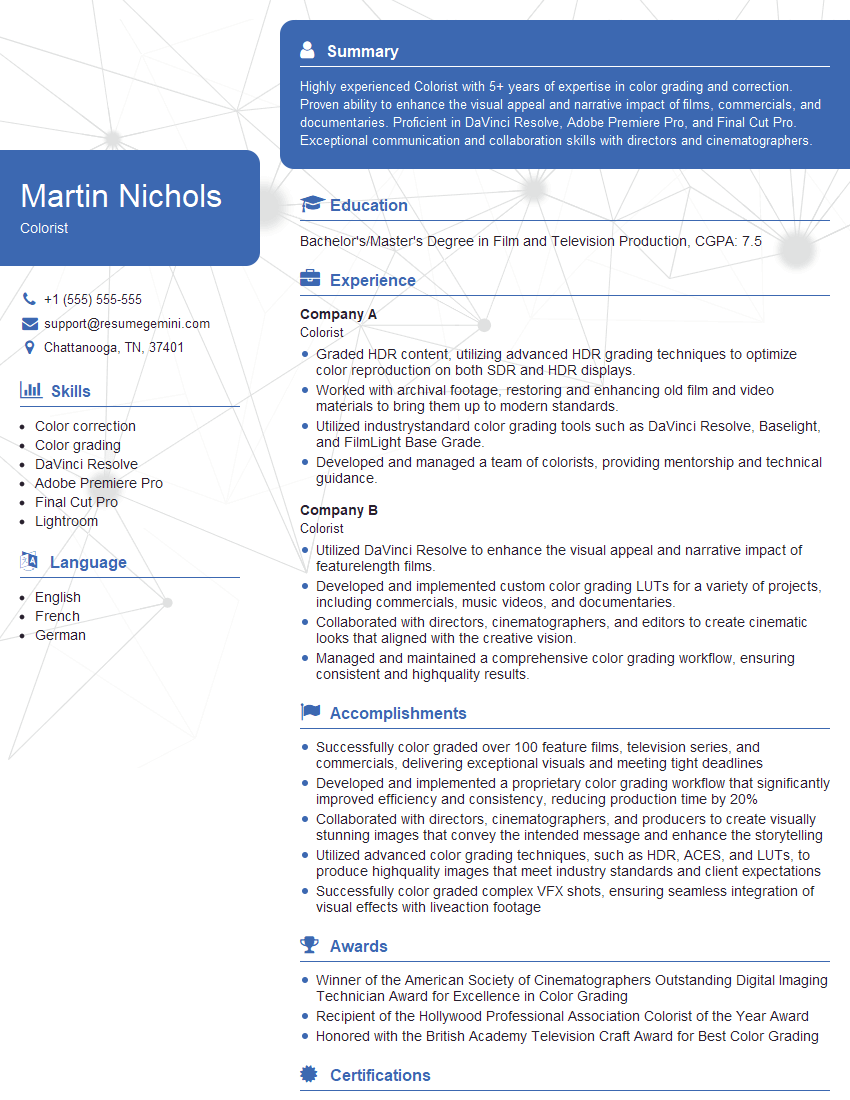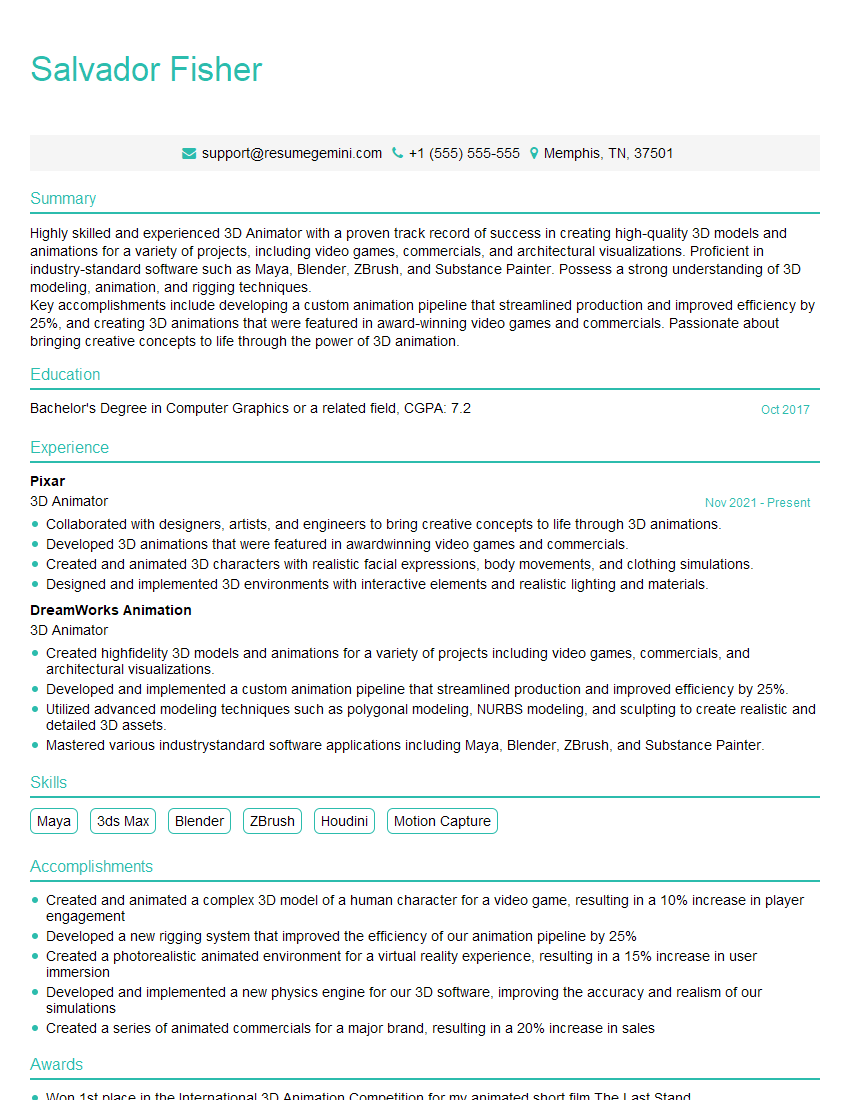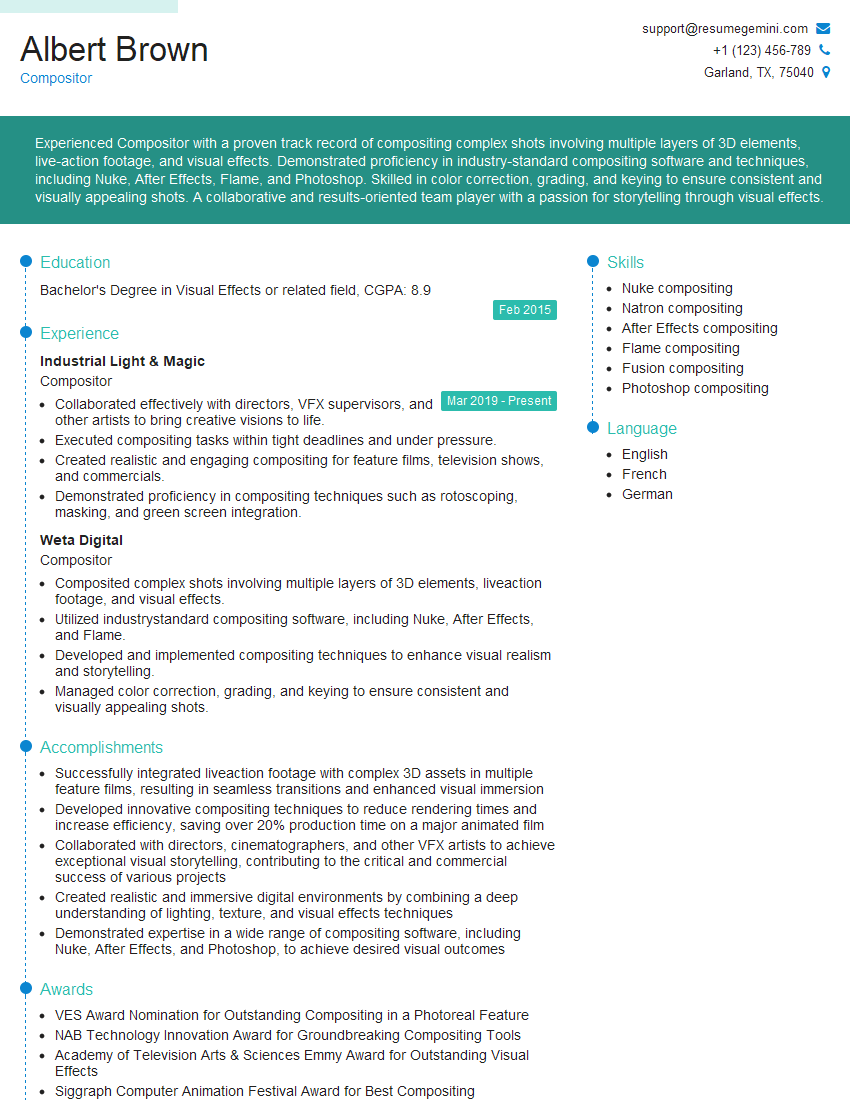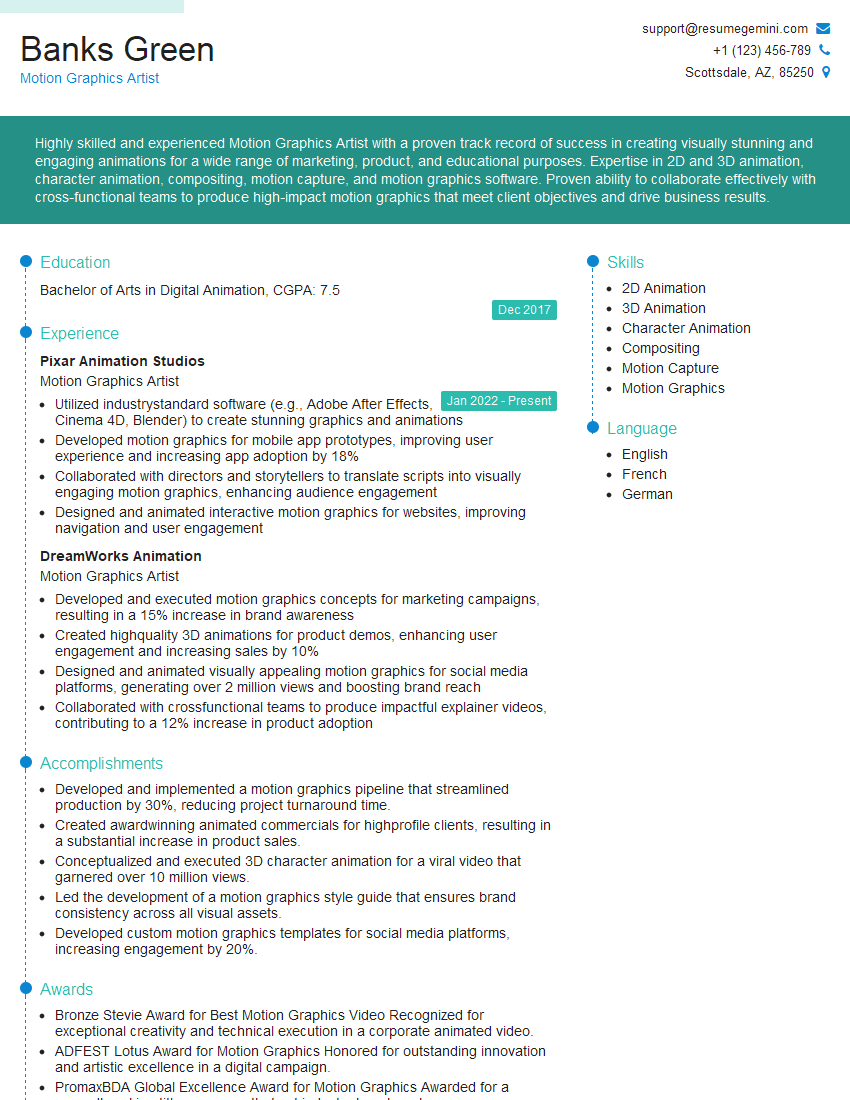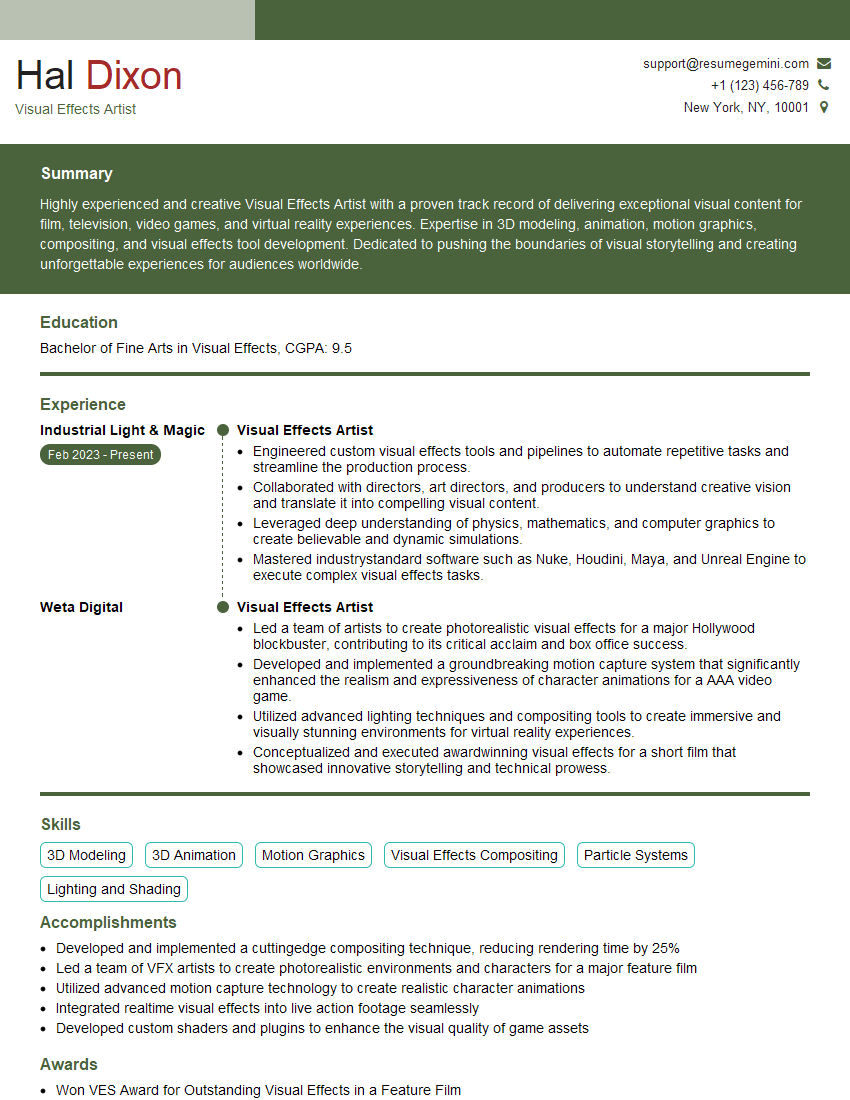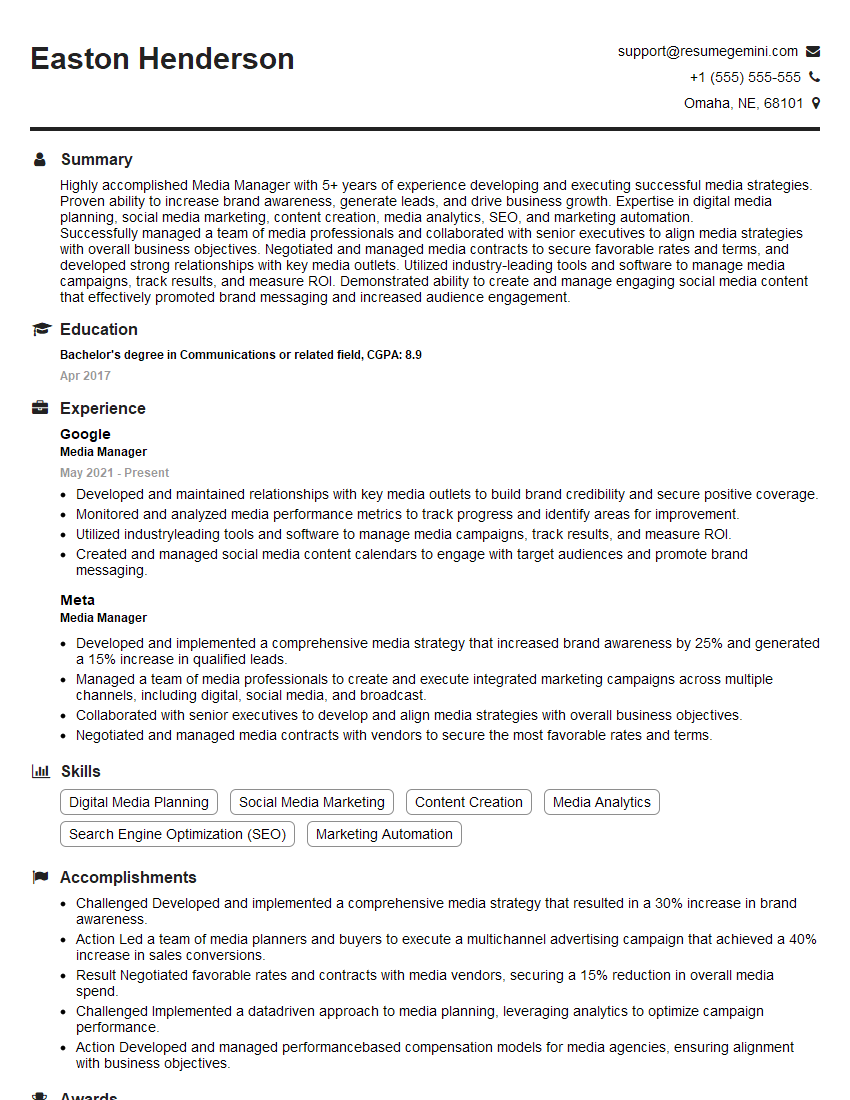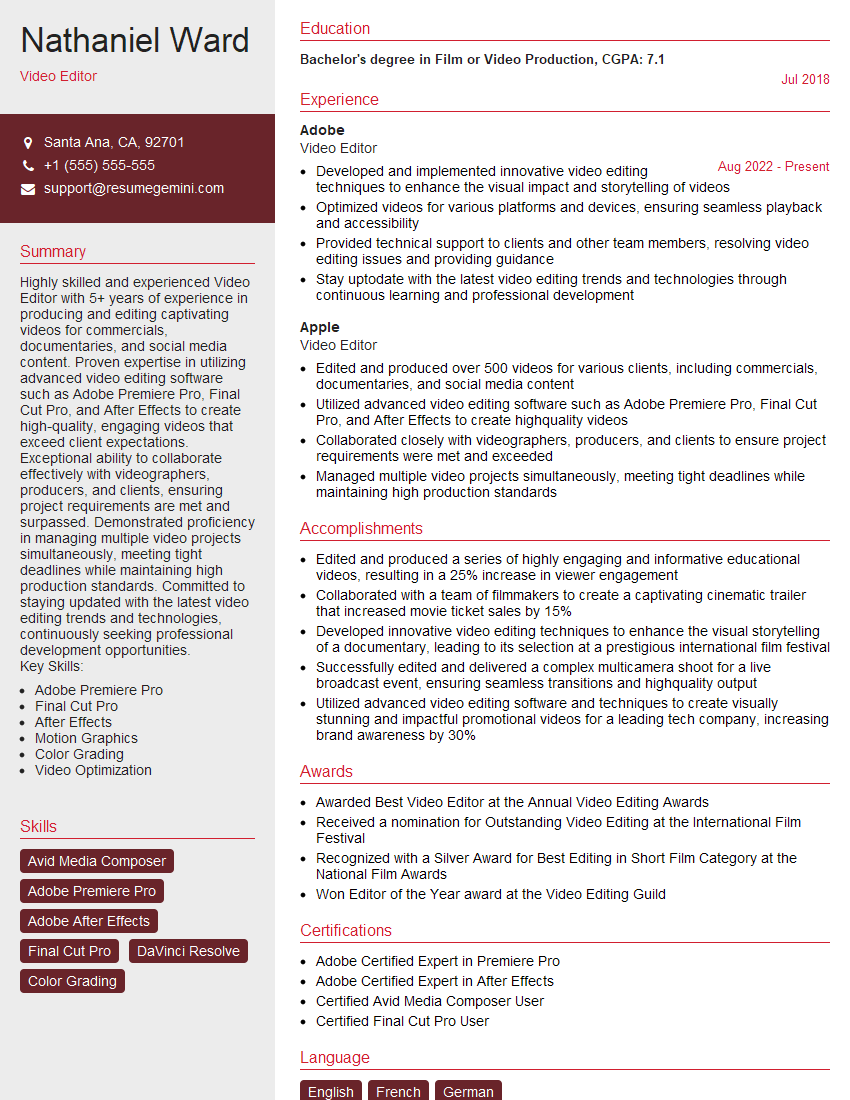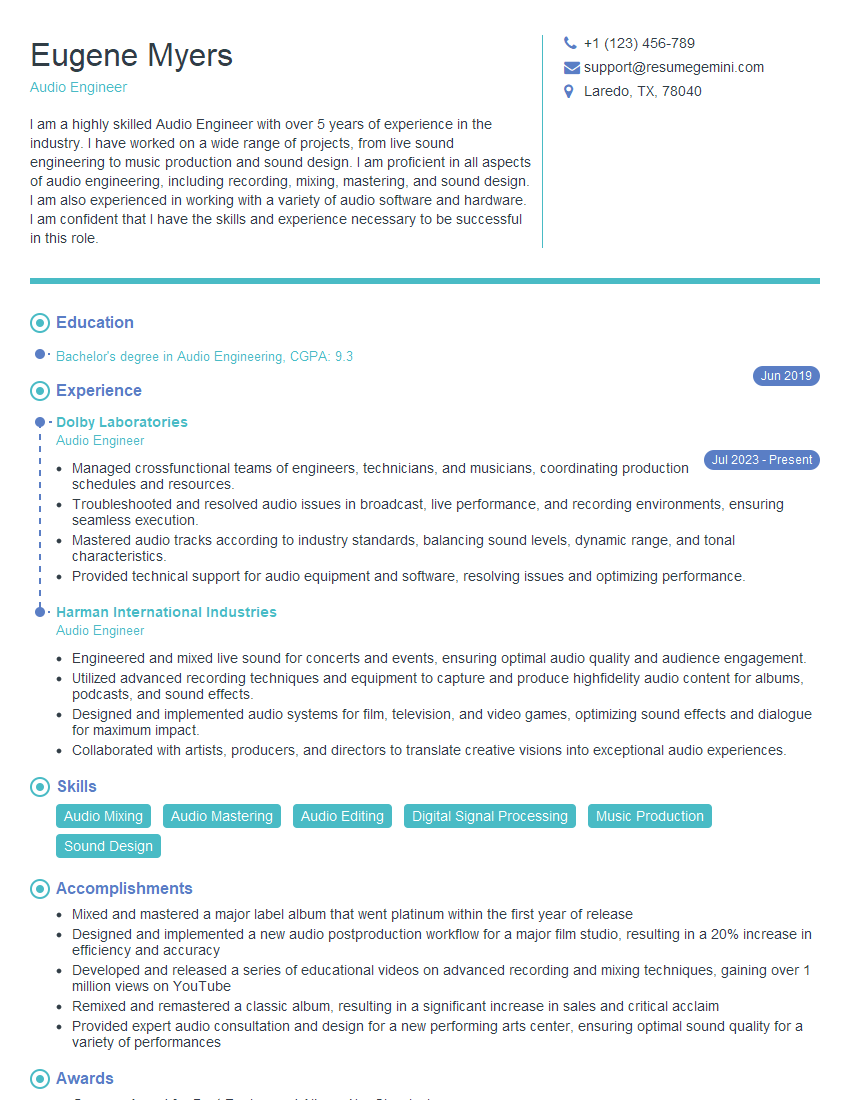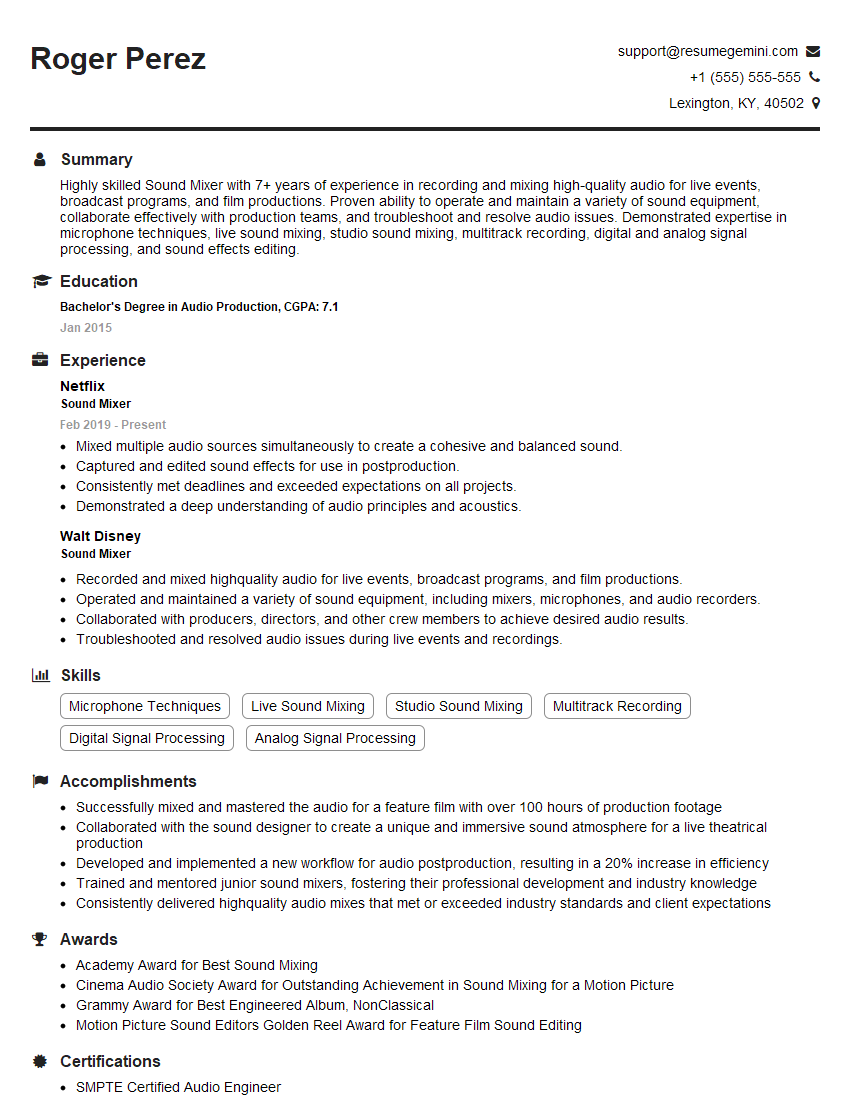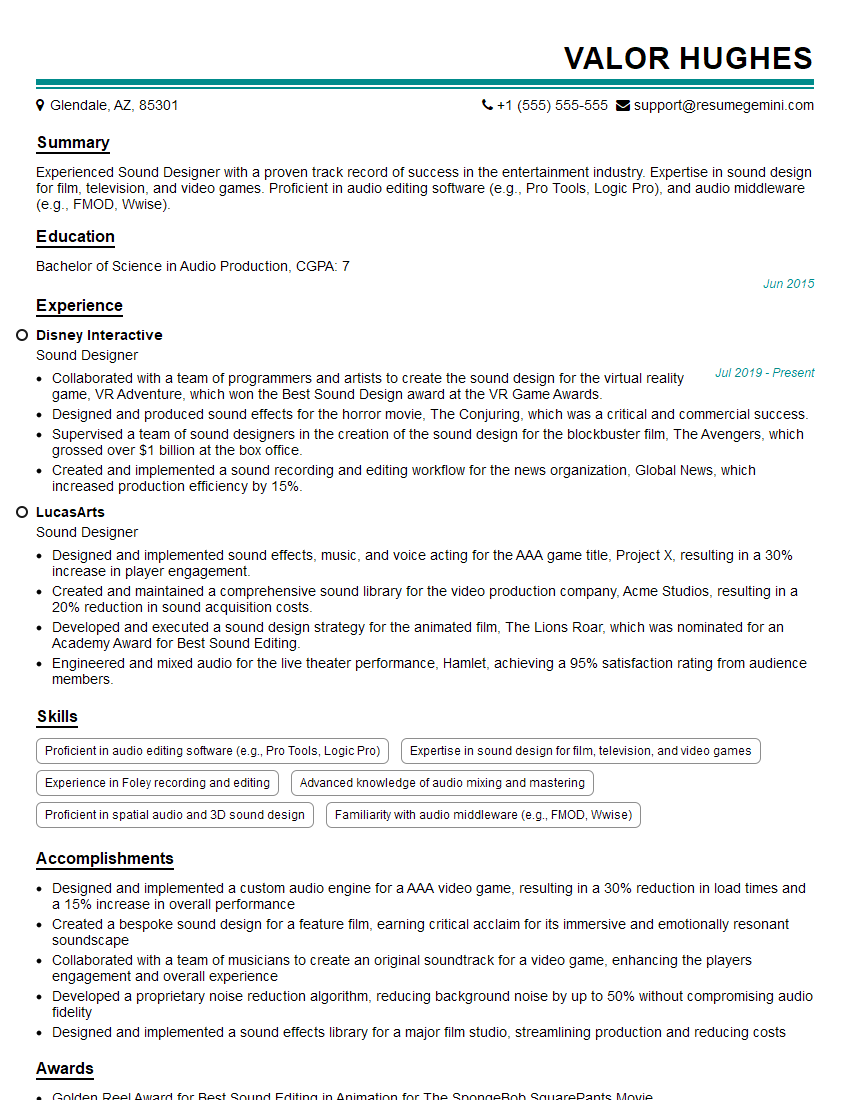Are you ready to stand out in your next interview? Understanding and preparing for PostProduction Techniques interview questions is a game-changer. In this blog, we’ve compiled key questions and expert advice to help you showcase your skills with confidence and precision. Let’s get started on your journey to acing the interview.
Questions Asked in PostProduction Techniques Interview
Q 1. Explain your experience with different video editing software (e.g., Premiere Pro, Final Cut Pro, Avid).
My experience spans several leading video editing platforms. Premiere Pro is my primary software, and I’m highly proficient in its advanced features like Lumetri Color, dynamic linking, and efficient workflow management. I’ve used it extensively for everything from short-form social media content to long-form documentaries. Final Cut Pro, while less frequently used recently, is familiar to me, particularly its magnetic timeline and robust organizational tools. Its speed and simplicity are great for certain projects. I also possess experience with Avid Media Composer, particularly useful for larger-scale collaborative projects, where its robust features for multi-user editing and version control are indispensable. I’m adept at adapting my editing style to the specific requirements and strengths of each platform. For instance, Premiere Pro’s versatility shines in complex projects with many visual effects, while Final Cut Pro’s speed is ideal for quick turnaround jobs.
Q 2. Describe your workflow for color correction and grading.
My color correction and grading workflow is a methodical process, starting with a careful assessment of the footage. I begin with color correction, aiming for a consistent look across all shots, addressing issues like white balance and exposure inconsistencies. I typically use a three-way color corrector to fine-tune individual color channels, making adjustments to shadows, mid-tones, and highlights. After color correction, I move to color grading, where I introduce creative stylistic choices to enhance the mood and narrative. This often involves using color wheels and curves to shape the overall tone, perhaps introducing a cinematic teal and orange look, or a desaturated, moody palette. I consistently utilize scopes (vectorscope, waveform monitor, parade) to ensure accuracy and prevent color clipping. A recent project involved grading a nature documentary, where I employed subtle color grading to evoke a sense of tranquility, while another corporate video required a bold and vibrant color palette to match the brand’s energetic style. The key is understanding the story and using color to support it.
Q 3. How do you handle audio mixing and mastering in post-production?
Audio post-production is crucial. My audio mixing workflow starts with cleaning up individual audio tracks – removing noise, hiss, and pops. Then I work on dialogue editing, syncing audio with video, and applying noise reduction where necessary. I carefully balance dialogue with sound effects and music, creating a clear and immersive soundscape. Often, I use techniques like panning to position sounds within the soundscape, giving a sense of space and depth. Mastering involves applying final equalization, compression, and limiting to optimize the audio for the target platform (streaming, cinema, etc.). I usually work within dedicated DAWs (Digital Audio Workstations) like Pro Tools or Logic Pro X, utilizing plugins for various processes. For instance, a recent project required meticulous sound design for a fantasy short film, involving creating custom sound effects and carefully layering ambient sounds to build atmosphere. Another project focused on ensuring crystal-clear dialogue for a corporate training video, requiring careful noise reduction and equalization.
Q 4. What are your preferred methods for noise reduction and audio cleanup?
My preferred methods for noise reduction and audio cleanup leverage a combination of techniques. For noise reduction, I often utilize spectral editing in my DAW to selectively target and remove unwanted frequencies. This is particularly effective in dealing with consistent background noise, like hum or hiss. I also employ various plugins designed for noise reduction, such as iZotope RX, which offers advanced algorithms for noise reduction, de-clicking, and de-essing. For audio cleanup, I often start with careful editing – cutting out unwanted sounds and glitches. This is followed by using equalization to boost or cut specific frequencies to improve clarity and balance. For example, de-essing is often used to tame harsh sibilance (hissing ‘s’ sounds) in dialogue tracks. A recent project involved cleaning up audio recorded in a noisy environment; using a combination of spectral editing and noise reduction plugins, I was able to restore the audio to a usable and professional standard.
Q 5. Explain your experience with visual effects (VFX) compositing.
My VFX compositing experience involves using software like After Effects and Fusion. I’m skilled in rotoscoping (isolating elements within footage), keying (separating subjects from backgrounds), tracking (matching movement between shots), and working with 3D elements and particle effects. My approach is always to start with good planning – carefully preparing elements in their respective applications before bringing them into the compositing software. A key aspect of my compositing workflow is maintaining consistent lighting and shadows to ensure a seamless integration of elements. For instance, I recently composited a CGI dragon into a live-action scene, using tracking to match the dragon’s movements to the camera’s movements. This required careful masking, color matching, and shadow adjustments to make the dragon look realistically integrated into the scene. Another project required more subtle work, rotoscoping and removing unwanted objects from several shots to ensure a clean final look.
Q 6. How do you manage large video projects and collaborate effectively with a team?
Managing large video projects and collaborating effectively require a structured approach. I rely heavily on project management tools like Asana or Wrike to organize tasks, deadlines, and asset management. Clear communication is paramount. I foster collaboration through regular team meetings, clear task assignments, and the consistent use of shared online storage and version control. Working with clients involves frequent updates, ensuring they are involved in the process and informed about progress. For large projects, breaking down the post-production process into manageable segments is vital, allowing for efficient delegation and tracking of progress. For example, on a recent multi-camera event shoot, I organized a team, assigning specific editing tasks to each member while maintaining a centralized asset library using a cloud-based platform. This ensured a smooth and efficient workflow, resulting in a polished final product.
Q 7. Describe your troubleshooting skills when dealing with technical issues in post-production.
My troubleshooting skills are honed from years of experience. I approach technical issues systematically, starting with identifying the nature of the problem. I’ll check for obvious causes first, like incorrect file formats, corrupted files, or hardware malfunctions. I utilize online forums, documentation, and my network of colleagues to find solutions. For software-related issues, I usually start by restarting the application or the computer. If the problem persists, I’ll try reinstalling drivers, updating software, or checking for conflicts with other applications. For hardware problems, I’ll check cables and connections. I always back up my projects regularly to prevent data loss in case of unforeseen issues. For example, I once encountered an issue with a corrupted media file that resulted in playback errors. After trying several troubleshooting steps, I managed to recover the file by utilizing a data recovery tool. Another time, a codec issue resulted in compatibility problems. The solution was to update the necessary codec packs for the project.
Q 8. What is your experience with different codecs and their impact on workflow?
Codec selection significantly impacts post-production workflow, affecting storage space, processing speed, and overall image quality. Different codecs prioritize different aspects – some favor compression efficiency (smaller file sizes), while others focus on preserving image quality, even at the cost of larger files.
- ProRes (Apple ProRes): A family of codecs known for their high quality and relatively fast rendering times. Ideal for high-resolution work and projects where quality is paramount, even if file sizes are larger. Commonly used in high-end film and television post-production.
- DNxHD (Avid DNxHD): Another high-quality codec, offering good balance between quality and file size. Popular within Avid workflows but usable across platforms.
- H.264/AVC: Widely used for internet distribution due to its excellent compression, leading to smaller files. However, it’s more computationally intensive to decode and re-encode, making it less suitable for intermediate steps in high-resolution projects. It’s a good choice for final delivery formats designed for web platforms.
- H.265/HEVC: The successor to H.264, offering even better compression ratios but requiring more processing power. Finding broader adoption in online platforms and streaming services.
In my workflow, I carefully choose the codec based on the project’s requirements and constraints. For example, a high-end feature film might use ProRes throughout the edit and color grading stages, switching to a more compressed codec like H.264 or H.265 only for the final delivery masters.
Q 9. How do you ensure the quality and consistency of your work throughout the post-production process?
Maintaining quality and consistency is paramount. My approach involves a multi-faceted strategy focusing on establishing a standardized workflow and leveraging tools for quality control.
- Color Management: I utilize a calibrated monitor with a colorimeter and ensure consistent color spaces (Rec.709 for broadcast, DCI-P3 for cinema) throughout the pipeline. Color grading is done using LUTs (Look-Up Tables) to ensure consistent looks across different shots and sequences.
- Version Control: I use a robust version control system like Adobe After Effects’ Version Cue or a dedicated media asset management system to track changes and revert to earlier versions if needed. This also facilitates collaboration.
- Regular QC Checks: I perform frequent quality control checks at various stages of the post-production process to catch errors early. This includes frame-by-frame reviews for continuity, audio levels, and visual effects consistency.
- Detailed Checklists: I employ comprehensive checklists for each stage to ensure nothing is missed, from metadata tagging to final export settings.
For instance, on a recent documentary project, implementing a strict color management workflow prevented inconsistencies in color grading across various cameras and shooting conditions.
Q 10. Explain your understanding of color spaces (e.g., Rec.709, DCI-P3).
Color spaces define the range of colors a system can reproduce. Different spaces cater to different output mediums. For example:
- Rec.709: The standard color space for HDTV and most online video. It’s a relatively small color gamut, meaning it can’t reproduce the full range of colors visible to the human eye.
- DCI-P3: A wider color gamut than Rec.709, used in digital cinema projection. It encompasses a significantly larger range of colors, resulting in a more vibrant and saturated image. It is becoming more common for HDR content.
- Adobe RGB: A wide gamut color space often used in print and photography, capable of capturing a larger range of colors than Rec. 709, but not quite as wide as DCI-P3.
Understanding color spaces is crucial to avoid color shifts when transferring footage between different systems or preparing it for various distribution platforms. For instance, if I’m editing footage shot in DCI-P3 and intend to deliver it for broadcast (Rec.709), I must ensure a proper color transform is applied to avoid clipping or inaccurate color representation.
Q 11. What are your methods for managing and organizing media assets?
Media asset management (MAM) is critical. My approach combines robust folder structures with database-driven MAM systems.
- Organized Folder Structure: I use a hierarchical folder structure based on project name, date, and asset type (e.g.,
Project_Name/2024-03-15/Footage/Audio/Graphics). - Metadata Tagging: Every asset is meticulously tagged with descriptive metadata, including keywords, scene numbers, shot descriptions, and relevant details. This allows easy searching and retrieval.
- MAM Software: I leverage MAM software like Adobe Prelude or dedicated MAM systems to provide a centralized database for managing and tracking all project assets. This ensures easy access and simplifies collaboration.
- Cloud Storage: I utilize cloud storage services for backups and collaboration, ensuring secure and accessible storage of assets even in case of equipment failure.
This structured approach significantly reduces search time and improves efficiency. For example, finding a specific shot within a large project becomes straightforward using keywords in a properly tagged database.
Q 12. Describe your experience with motion graphics and animation.
I have extensive experience with motion graphics and animation using software like Adobe After Effects and Cinema 4D. My skills range from creating simple lower thirds and animated titles to complex 3D animations and visual effects.
- 2D Animation: Proficient in creating animated logos, explainer videos, and motion graphics using keyframing, shape layers, and expressions.
- 3D Animation: Experience in modeling, texturing, rigging, animating, and rendering 3D models within Cinema 4D and other similar packages. I can integrate 3D elements seamlessly into live-action footage.
- Compositing: Skilled in compositing multiple layers of video and graphic elements to create complex visual effects.
- Visual Effects: I have experience working with rotoscoping, keying, and other visual effects techniques to enhance footage.
For instance, in a recent project, I created an animated sequence explaining a complex scientific concept using After Effects, creating engaging visualizations that simplified the information for the audience.
Q 13. How do you balance creative vision with client expectations in post-production?
Balancing creative vision with client expectations requires careful communication and collaboration. The key is to establish a clear understanding of their objectives from the beginning.
- Initial Consultation: I start with detailed discussions with the client to understand their vision, target audience, and desired outcome. We review existing materials and define clear goals.
- Presentation of Concepts: I present multiple concept options and revisions to allow clients to provide feedback and guide the creative direction. This iterative process ensures alignment.
- Regular Feedback Sessions: I hold regular check-in meetings throughout the post-production process to share progress and address any concerns.
- Managing Expectations: It’s crucial to manage expectations by explaining realistic timelines and potential limitations.
In one project, a client had a very specific vision, but it presented technical challenges. Through open communication and collaboration, we found a creative solution that met their expectations while maintaining high quality. It involved a compromise, where some elements were adjusted to ensure feasibility without impacting the overall aesthetic significantly.
Q 14. Explain your understanding of different audio formats and their applications.
Understanding audio formats is essential for optimal sound quality and efficient workflow. Different formats offer varying degrees of compression, bit depth, and sample rates, each suited to specific applications.
- WAV: An uncompressed audio format, offering high-fidelity audio quality. Ideal for mastering and archiving, but results in large file sizes.
- AIFF: Another uncompressed format, similar to WAV, used primarily on Apple systems.
- MP3: A widely used compressed format, providing a balance between quality and file size. Good for online distribution and streaming, but can result in some loss of audio fidelity compared to uncompressed formats.
- AAC: Another lossy compressed format, often used for streaming services and mobile devices, typically offering better quality than MP3 at comparable bitrates.
- FLAC: A lossless compressed format offering high-quality audio with smaller file sizes than WAV or AIFF. It’s a good choice for archiving high-quality audio without compromising quality.
During post-production, I might use WAV for editing and mixing in a DAW (Digital Audio Workstation) to maintain audio quality. However, for delivery to various platforms, I’d export to more compressed formats such as MP3 or AAC, ensuring the chosen format aligns with the intended use and platform requirements.
Q 15. Describe your experience with delivering final video files in various formats.
Delivering final video files requires a deep understanding of codecs, resolutions, and target platforms. My experience spans a wide range of formats, from broadcast-ready ProRes 422 HQ for high-end television work to more compressed formats like H.264 or H.265 for web delivery. For example, a client needing a YouTube upload would receive an H.264 file optimized for web streaming, while a broadcast client would receive a ProRes file for maximum quality and editability. I always consider the client’s intended use and platform before choosing the final format. This involves careful consideration of factors like file size, bandwidth requirements, and the desired level of quality. I also ensure metadata is correctly embedded in the files, including date, time, project name, and any other relevant information. The process frequently includes creating multiple masters – one for archiving and future use in high resolution, and then one or more optimized versions for the client’s specific needs.
- H.264/AVC: Widely used for web videos due to its good balance of quality and compression.
- H.265/HEVC: More efficient compression than H.264, resulting in smaller file sizes for the same quality.
- ProRes: High-quality, lossless or near-lossless codec commonly used for post-production editing and intermediate deliverables.
- DNxHD: Another popular high-quality codec used in professional workflows.
Career Expert Tips:
- Ace those interviews! Prepare effectively by reviewing the Top 50 Most Common Interview Questions on ResumeGemini.
- Navigate your job search with confidence! Explore a wide range of Career Tips on ResumeGemini. Learn about common challenges and recommendations to overcome them.
- Craft the perfect resume! Master the Art of Resume Writing with ResumeGemini’s guide. Showcase your unique qualifications and achievements effectively.
- Don’t miss out on holiday savings! Build your dream resume with ResumeGemini’s ATS optimized templates.
Q 16. How do you handle feedback and revisions from clients or directors?
Handling feedback and revisions is crucial for client satisfaction. My approach involves active listening, detailed note-taking, and clear communication. I use a collaborative system – often a shared project management tool – where clients can directly comment on specific timestamps within the video. This allows for precise feedback and avoids ambiguity. Once feedback is received, I prioritize revisions based on urgency and impact. I always present multiple options for solutions, when possible, to give the client a choice and ensure they’re happy with the final outcome. For instance, if a client wants a scene shortened, I might provide two or three different versions with varying lengths to allow them to choose the best option. I believe in transparency throughout the revision process, keeping the client informed about the progress and estimated time for completion. A final review is always conducted before delivery, ensuring all concerns are addressed.
Q 17. What is your approach to quality control and error detection in post-production?
Quality control is an ongoing process, not just a final step. I employ a multi-layered approach. Firstly, I meticulously review every stage of the post-production process. Secondly, I utilize software tools for audio and video analysis to detect issues like audio dropouts, video glitches, or color imbalances that might be missed by the human eye. Thirdly, a rigorous quality control check is performed on the final master before delivery. This often involves multiple team members viewing the video on different platforms and devices to catch any inconsistencies. We use checklists to ensure all aspects, like subtitles, graphics, and sound levels, are consistent with the client’s requirements and industry best practices. Finally, test renders are conducted at various stages, even before final compression to confirm color accuracy and identify problems early. Think of it like baking a cake; you check it several times throughout the process to ensure it is cooked perfectly.
Q 18. Describe your experience with version control and archiving projects.
Version control and archiving are fundamental for efficient workflow and disaster recovery. I use a robust system involving a combination of cloud-based storage and local backups. Every project gets its own unique folder structure with clearly labeled versions, and all previous versions are carefully archived. For instance, I’ll have a folder for each edit, clearly labeled as ‘Edit v1,’ ‘Edit v2,’ etc., including all associated files. This allows easy retrieval of any previous version if needed. We utilize version control software (like a cloud based platform) that tracks all changes, allowing us to revert to earlier versions if necessary. This is critical for larger projects with multiple collaborators. Furthermore, Metadata is meticulously maintained for each version for quick access and clear identification. All archive files are stored in multiple locations, following a clear naming convention to prevent confusion and data loss.
Q 19. What are your preferred methods for creating subtitles and closed captions?
My preferred method for creating subtitles and closed captions combines automation with meticulous manual review. I utilize software like Adobe Premiere Pro’s built-in captioning tools or dedicated captioning software. These tools often allow for automated transcription, which I then carefully review and edit for accuracy and timing. This ensures that the captions are not only accurate but also seamlessly integrated with the video. For languages other than English, I collaborate with professional translators to guarantee accurate translation. Beyond accuracy, I also prioritize readability and accessibility, adhering to established guidelines and best practices for subtitle and caption formatting. This includes considerations for font size, color contrast, and placement on screen to ensure ease of viewing for the audience. Finally, a thorough quality check is done before adding to the final product.
Q 20. Explain your understanding of different compression techniques for video and audio.
Compression techniques are essential for managing file sizes without sacrificing too much quality. For video, codecs like H.264 and H.265 offer efficient compression by discarding information the human eye is less likely to notice. H.265 is generally more efficient, leading to smaller files for the same quality. The choice depends on the target platform and desired quality level. High-quality codecs like ProRes are used for intermediate files in editing but are much larger in file size. For audio, lossy compression techniques like AAC (Advanced Audio Coding) and MP3 are widely used for distribution, prioritizing smaller file sizes over absolute fidelity. Lossless compression, such as WAV or FLAC, preserves all audio data but results in larger files. The choice depends on the application: MP3 is acceptable for casual listening, while WAV or FLAC are better suited for archiving and professional use. Understanding the trade-offs between file size, quality, and codec choice is key to effective post-production.
Q 21. How do you manage time effectively to meet deadlines in post-production?
Effective time management in post-production hinges on careful planning and prioritization. I begin by creating a detailed schedule, breaking down the project into manageable tasks with realistic deadlines. I use project management tools to track progress and identify potential bottlenecks. This often involves close collaboration with the team and the client to establish clear expectations and manage revisions effectively. I prioritize tasks based on their importance and urgency, focusing on critical elements first. Furthermore, I dedicate specific time blocks for focused work, minimizing interruptions. Regular communication with clients and team members prevents misunderstandings and keeps the project on track. Finally, contingency time is always built into the schedule to account for unexpected issues or revisions. Proactive planning and consistent monitoring of the timeline is vital to delivering the final product on time.
Q 22. What is your experience with working on different types of projects (e.g., documentaries, commercials, feature films)?
My post-production experience spans a diverse range of projects, giving me a well-rounded understanding of the nuances involved in each. I’ve worked extensively on documentaries, where the focus is on meticulous archival footage handling, color correction to maintain a consistent look and feel across different sources, and subtle sound design to enhance narrative. Commercials demand a fast turnaround and a high polish, requiring efficient workflows and a keen eye for detail in areas like visual effects and motion graphics. Finally, feature films offer a different scale altogether, involving intricate collaboration across multiple departments, complex visual effects pipelines, and extensive color grading to achieve the director’s vision. Each project type presents unique challenges and rewards, shaping my approach to problem-solving and collaboration.
- Documentaries: Worked on a project involving the restoration of 8mm film footage, requiring careful stabilization and noise reduction techniques.
- Commercials: Led the post-production on a series of short commercials, implementing fast turnaround VFX to meet tight deadlines.
- Feature Films: Contributed to the color grading of an independent feature film, working closely with the director and cinematographer to refine the overall look.
Q 23. Describe your knowledge of different camera formats and their implications on post-production.
Understanding camera formats is fundamental to successful post-production. The format significantly impacts resolution, dynamic range, color science, and ultimately, the final image quality and the workflow needed to achieve the desired outcome. For example, shooting in RAW provides maximum flexibility in post-production, allowing for extensive color grading and detail recovery, but requires significantly more storage and processing power. Shooting in a compressed format like H.264 might lead to better storage efficiency and faster turnaround, but limits the flexibility for adjustments in post.
- RAW: Offers maximum dynamic range and color information, ideal for high-end productions where flexibility is paramount. Requires more storage and processing power.
- Log: A wide dynamic range format that aims to capture more information, similar to RAW, but is still compressed offering a balance between flexibility and storage.
- Rec.709: A standard HDTV color space suitable for direct use and often doesn’t require significant color transformation.
The choice of format always involves a trade-off between quality, efficiency, and cost. My experience allows me to make informed decisions based on the project’s needs and budget constraints.
Q 24. How do you stay updated with the latest technologies and trends in post-production?
Staying current in the rapidly evolving field of post-production is crucial. I actively engage in several strategies:
- Industry publications and websites: I regularly read publications like No Film School, PremiumBeat, and Creative COW, staying abreast of new software releases, workflow improvements, and emerging trends.
- Conferences and workshops: Attending industry events like NAB Show and IBC provides direct access to leading experts and new technologies.
- Online courses and tutorials: Platforms like Skillshare, Udemy, and LinkedIn Learning offer valuable training on new software and techniques.
- Networking: Participating in online communities and forums allows for discussion and problem-solving with other post-production professionals.
This multi-faceted approach ensures that I’m well-equipped to tackle any post-production challenge with the most efficient and effective tools.
Q 25. Explain your experience with creating and managing project timelines.
Creating and managing project timelines is a critical skill for post-production. I use a combination of software and methodologies to ensure projects stay on track. I begin with a detailed breakdown of each stage of the post-production process: ingest, editing, VFX, color grading, sound mixing, mastering, etc. Then, I assign realistic timeframes to each task, considering factors like complexity, team size, and potential delays. I utilize project management software such as Asana or Monday.com to track progress, manage tasks, and communicate with team members. Regular check-ins and progress reports help identify potential roadblocks and adjust timelines proactively. Critical path analysis helps prioritize crucial tasks and minimize delays.
For example, in a recent documentary project, I identified a potential bottleneck in archival footage restoration. By proactively allocating additional time and resources to this stage, we avoided significant delays in the overall timeline.
Q 26. How familiar are you with digital asset management (DAM) systems?
I am very familiar with various digital asset management (DAM) systems. These systems are essential for organizing, storing, and retrieving large volumes of media files efficiently. My experience includes working with both cloud-based solutions like Adobe Creative Cloud and on-premise systems. Understanding metadata tagging, keywording, and version control is crucial for seamless collaboration and efficient retrieval of assets during the post-production process. This ensures that the right footage, graphics, and audio files are readily available to the team, preventing delays and streamlining the workflow. I am proficient in utilizing DAM systems to implement a robust and organized workflow which ultimately saves time and reduces the risk of errors.
Q 27. Describe your understanding of colorimetry and its importance in post-production.
Colorimetry is the science and technology of measuring, representing, and reproducing color. In post-production, it’s crucial for achieving accurate and consistent color throughout a project. This involves understanding color spaces (like Rec.709, DCI-P3, and Adobe RGB), color profiles, and color grading techniques. Accurate colorimetry ensures that the final product looks as intended, whether it’s a vibrant commercial or a naturalistic documentary. Understanding colorimetry helps avoid issues like color casts, incorrect skin tones, and inconsistent color across different shots or scenes. Tools like colorimeters and calibration software are used to ensure monitors and projectors are accurately displaying colors, allowing for consistent color grading decisions.
Q 28. What are some common challenges you face in post-production and how do you overcome them?
Post-production often presents numerous challenges. One common issue is managing large file sizes and storage requirements, especially with high-resolution footage. We overcome this through efficient compression techniques and utilizing cloud storage solutions. Another frequent challenge is meeting tight deadlines, especially in commercial projects. Careful planning, efficient workflows, and effective team communication are essential for successful project delivery within these constraints. Finally, creative differences between clients and creative teams can be difficult to navigate. Open communication, compromise, and clear articulation of creative choices are crucial in resolving these conflicts. I actively address these challenges by employing robust planning, efficient technology, clear communication, and a proactive approach to problem-solving.
Key Topics to Learn for PostProduction Techniques Interview
- Color Grading and Correction: Understanding color spaces (e.g., RGB, XYZ), color theory, and the practical application of color grading tools in software like DaVinci Resolve or Adobe Premiere Pro. Mastering techniques for balancing, correcting, and creatively enhancing color palettes.
- Audio Post-Production: Familiarize yourself with audio editing software (e.g., Audacity, Pro Tools), noise reduction, dialogue editing, sound design, and mixing techniques. Be prepared to discuss strategies for achieving clear, balanced, and engaging audio.
- Video Editing Techniques: Demonstrate proficiency in non-linear editing workflows, including cutting, assembling, and sequencing footage. Understand different editing styles and their application, and be ready to discuss your approach to storytelling through editing.
- Visual Effects (VFX): Gain foundational knowledge of compositing, keying, and motion tracking techniques. Understanding the workflow and software commonly used for VFX (e.g., After Effects, Nuke) will be beneficial.
- Workflow and Collaboration: Showcase your understanding of efficient post-production workflows, including file management, organization, and collaboration with other team members. Discuss version control and best practices for maintaining project integrity.
- Software Proficiency: Be prepared to discuss your experience with industry-standard software relevant to your specialization within post-production. Highlight your expertise and problem-solving skills within these programs.
- Troubleshooting and Problem-Solving: Demonstrate your ability to identify and resolve common technical issues encountered in post-production. Highlight your experience handling unexpected challenges and finding creative solutions.
Next Steps
Mastering PostProduction Techniques is crucial for a successful and rewarding career in film, television, and digital media. It opens doors to a diverse range of exciting roles and allows you to contribute your creative skills to compelling projects. To maximize your job prospects, focus on creating an ATS-friendly resume that highlights your key skills and accomplishments. We highly recommend using ResumeGemini to build a professional and impactful resume. ResumeGemini offers valuable tools and resources to ensure your resume stands out. Examples of resumes tailored to PostProduction Techniques are available to help guide you.
Explore more articles
Users Rating of Our Blogs
Share Your Experience
We value your feedback! Please rate our content and share your thoughts (optional).
What Readers Say About Our Blog
Hello,
We found issues with your domain’s email setup that may be sending your messages to spam or blocking them completely. InboxShield Mini shows you how to fix it in minutes — no tech skills required.
Scan your domain now for details: https://inboxshield-mini.com/
— Adam @ InboxShield Mini
Reply STOP to unsubscribe
Hi, are you owner of interviewgemini.com? What if I told you I could help you find extra time in your schedule, reconnect with leads you didn’t even realize you missed, and bring in more “I want to work with you” conversations, without increasing your ad spend or hiring a full-time employee?
All with a flexible, budget-friendly service that could easily pay for itself. Sounds good?
Would it be nice to jump on a quick 10-minute call so I can show you exactly how we make this work?
Best,
Hapei
Marketing Director
Hey, I know you’re the owner of interviewgemini.com. I’ll be quick.
Fundraising for your business is tough and time-consuming. We make it easier by guaranteeing two private investor meetings each month, for six months. No demos, no pitch events – just direct introductions to active investors matched to your startup.
If youR17;re raising, this could help you build real momentum. Want me to send more info?
Hi, I represent an SEO company that specialises in getting you AI citations and higher rankings on Google. I’d like to offer you a 100% free SEO audit for your website. Would you be interested?
Hi, I represent an SEO company that specialises in getting you AI citations and higher rankings on Google. I’d like to offer you a 100% free SEO audit for your website. Would you be interested?
good
